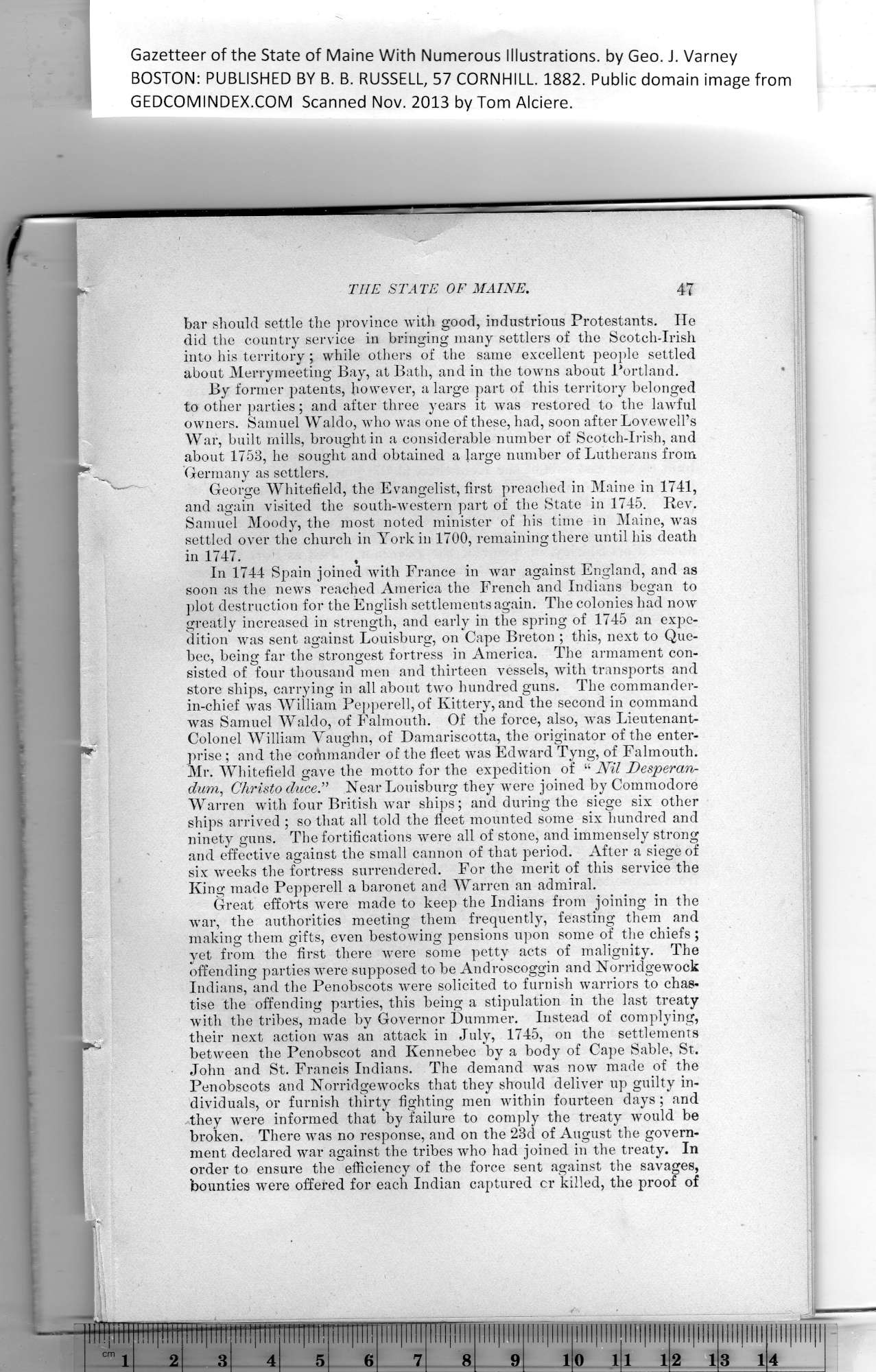|
Gazetteer of the State of Maine With Numerous Illustrations, by Geo. J. Varney
BOSTON: PUBLISHED BY B. B. RUSSELL, 57 CORNHILL. 1882. Public domain image from
THE STATE OF MAINE. 47
bar should settle the province with good, industrious Protestants. He
did the country service in bringing many settlers of the Scotch-Irish
into his territory; while others of the same excellent people settled
about Merrymeeting Bay, at Bath, and in the towns about Portland.
By former patents, however, a large part of this territory belonged
to other parties; and after three years it was restored to the lawful
owners. Samuel Waldo, who was one of these, had, soon after Lovewell’s
War, built mills, brought in a considerable number of Scotch-Irish, and
about 1753, he sought and obtained a large number of Lutherans from
Germany as settlers.
George Whitefield, the Evangelist, first preached in Maine in 1741,
and again visited the south-western part of the State in 1745. Rev.
Samuel Moody, the most noted minister of his time in Maine, was
settled over the church in York in 1700, remaining there until his death
in 1747.
In 1744 Spain joined tvith France in war against England, and as
soon as the news reached America the French and Indians began to
plot destruction for the English settlements again. The colonies had now
greatly increased in strength, and early in the spring of 1745 an expe-
dition was sent against Louisburg, on Cape Breton ; this, next to Que-
bec, being far the strongest fortress in America. The armament con-
sisted of four thousand men and thirteen vessels, with transports and
store ships, carrying in all about two hundred guns. The commander-
in-chief was William Pepperell, of Ivittery, and the second in command
was Samuel Waldo, of Falmouth. Of the force, also, was Lieutenant-
Colonel William Vaughn, of Damariscotta, the originator of the enter-
prise ; and the commander of the fleet was Edward Tyng, of Falmouth.
Mr. Whitefield gave the motto for the expedition of “ Nil Desperan-
durn, Christo duceC Near Louisburg they were joined by Commodore
Warren with four British war ships; and during the siege six other
ships arrived ; so that all told the fleet mounted some six hundred and
ninety guns. The fortifications were all of stone, and immensely strong
and effective against the small cannon of that period. After a siege of
six weeks the fortress surrendered. For the merit of this service the
King made Pepperell a baronet and Warren an admiral.
Great efforts wrnre made to keep the Indians from joining in the
war, the authorities meeting them frequently, feasting them and
making them gifts, even bestowing pensions upon some of the chiefs;
yet from the first there were some petty acts of malignity. The
offending parties were supposed to be Androscoggin and Norridgewock
Indians, and the Penobscots were solicited to furnish warriors to chas-
tise the offending parties, this being a stipulation in the last treaty
writh the tribes, made by Governor Dimmer. Instead of complying,
their next action was an attack in July, 1745, on the settlements
between tbe Penobscot and Kennebec by a body of Cape Sable, St.
John and St. Francis Indians. The demand was now made of the
Penobscots and Norridgewocks that they should deliver up guilty in-
dividuals, or furnish thirty fighting men within fourteen days ; and
they were informed that by failure to comply the treaty would be
broken. There was no response, and on the 23d of August the govern-
ment declared war against the tribes who had joined in the treaty. In
order to ensure tbe efficiency of tbe force sent against the savages,
bounties were offered for each Indian captured cr killed, the proof of
PREVIOUS PAGE ... NEXT PAGE
This page was written in HTML using a program written in Python 3.2
|
